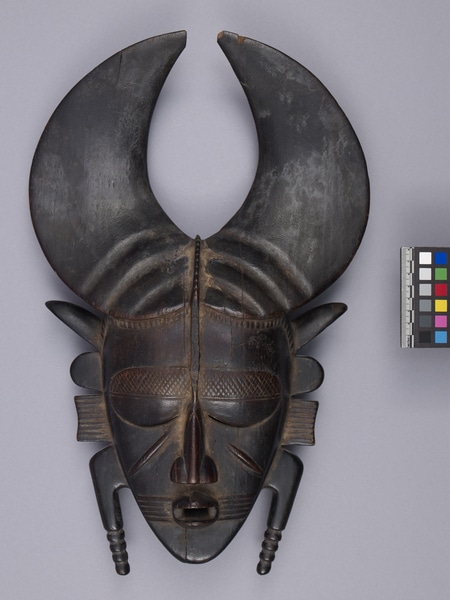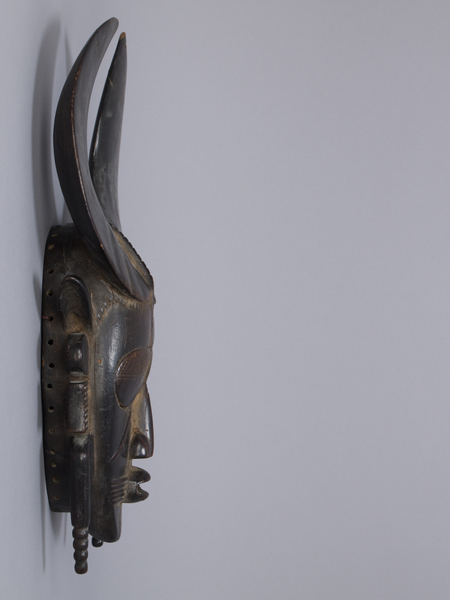Mask Item Number: 2960/14 from the MOA: University of British Columbia



Description
Carved wooden face mask topped by curved horns. The face is flat with a narrow rounded chin, widening toward the forehead. The mouth is small with protruding lips and a hole bored through the centre. To each side is a set of raised horizontal lines. The nose is wide at the nostrils and thin at the bridge. A diagonal line decorates the cheek to each side. Eyes are closed with wide curved slits as viewing holes. The brow is decorated with cross hatching. A raised line sits between the browns and extends to the top of the head, between two large, concave, inwardly curing horns that are ridged at bottom, smooth at top. Along the sides of the mask are four differently shaped protuberances, oval, rounded, square with horizontal lines, and leg shaped with ridges at the bottom. The interior of the mask is hollowed out, and has a set of evenly placed holes around the outer edge.
History Of Use
Kpelié (face masks) are idealized representations of the beauty of young women; they are used in funerary and initiation rites. Funerary masquerades, organized and performed by the Poro society of a given village, concentrate on honouring the dead and ensuring continuity between the living and the ancestral dead. Within the Fonombele blacksmith group, the Kodöli-yëhë masquerade dance utilizes these face masks in conjunction with specific hip and shoulder movements meant to refer to the feminine qualities of a beautiful young woman. Kodöli-yëhë serves as both entertainment in blacksmith funeral social festivities and as part of the initiation process for male Junior Grade members in blacksmith Poro societies. Kpelié are worn with raffia costumes and the dance is accompanied by songs, chants, and instruments. Until it's independence in 1960, Cote d'Ivoire remained under French rule and its policy of association. Indigenous Senufo groups were allowed to preserve their customs so long as they were compatible with French interests. However, following mass conversions to Christianity in southern Cote d'Ivoire in the early 20th century and the Massa iconoclast movement in southern Mali in the mid-20th century, many indigenous groups abandoned traditional visual culture. What was left behind was either collected or later replicated by Senufo artists for the art trade market.
Iconographic Meaning
The three lines that fan out from the corner of each side of the mouth are elemental motifs incised on every child, both male and female. This scarification (yegi kabaara, or “face scars”) identifies the person as Senufo. The carved horns seen on this mask were also used in sigi kun ("buffalo head"). Sigi kun were helmets used by Bamana and other Mande-language speakers hunters’ associations, in which buffalo horns were emblematic of male power and authority.
Item History
- Made in Cote d'Ivoire and Mali during 1950
- Owned by Robert Cazelais and Nicole Lachapelle before April 24, 2012
- Received from Robert Cazelais (Donor) on April 24, 2012
What
Who
- Culture
- Senufo
- Previous Owner
- Robert Cazelais and Nicole Lachapelle
- Received from
- Robert Cazelais (Donor)
Where
- Holding Institution
- MOA: University of British Columbia
- Made in
- Cote d'Ivoire and Mali
When
- Creation Date
- during 1950
- Ownership Date
- before April 24, 2012
- Acquisition Date
- on April 24, 2012
Other
- Condition
- fair
- Accession Number
- 2960/0014